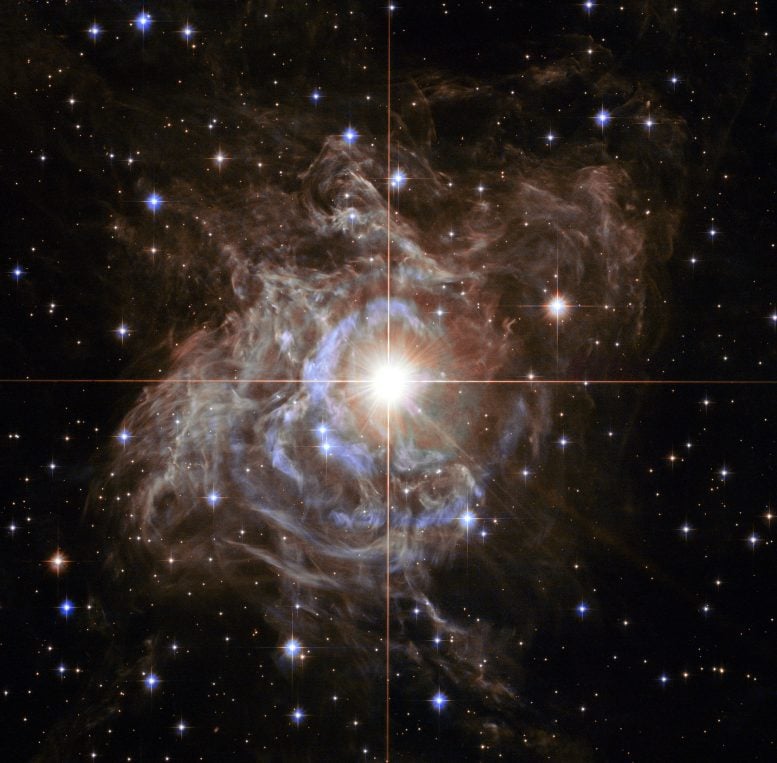
This Hubble image shows RS Puppis, a type of variable star known as a Cepheid variable. As variable stars go, Cepheids have comparatively long periods — RS Puppis, for example, varies in brightness by almost a factor of five every 40 or so days. RS Puppis is unusual; this variable star is shrouded by thick, dark clouds of dust enabling a phenomenon known as a light echo to be shown with stunning clarity. These Hubble observations show the ethereal object embedded in its dusty environment, set against a dark sky filled with background galaxies. Credit: NASA, ESA, and the Hubble Heritage Team (STScI/AURA)-Hubble/Europe Collaboration. Acknowledgment: H. Bond (STScI and Penn State University); ESA/Hubble & ESO
A new Hubblecast video explores the striking new Hubble observations of a variable star known as RS Puppis.
The NASA/ESA Hubble Space Telescope has observed the variable star RS Puppis over a period of five weeks, showing the star growing brighter and dimmer as it pulsates. These pulsations have created a stunning example of a phenomenon known as a light echo, where light appears to reverberate through the murky environment around the star.
For most of its life, a star is pretty stable, slowly consuming the fuel at its core to keep it shining brightly.
This episode of the Hubblecast explores striking new Hubble observations of a variable star known as RS Puppis. This star is growing brighter and dimmer as it pulsates over a period of five weeks. These pulsations have created a stunning example of a phenomenon known as a light echo, where light appears to reverberate through the foggy environment around the star.
However, once most of the hydrogen that stars use as fuel has been consumed, some stars evolve into very different beasts — pulsating stars. They become unstable, expanding and shrinking over a number of days or weeks and growing brighter and dimmer as they do so.
A new and spectacular Hubble image shows RS Puppis, a type of variable star known as a Cepheid variable.[1] As variable stars go, Cepheids have comparatively long periods. RS Puppis, for example, varies in brightness by almost a factor of five every 40 or so days.
This illustration shows an artist’s impression of the light echo around variable star RS Puppis.
RS Puppis is unusual as it is shrouded by a nebula — thick, dark clouds of gas and dust. Hubble observed this star and its murky environment over a period of five weeks in 2010, capturing snapshots at different stages in its cycle and enabling scientists to create a time-lapse video of this ethereal object.
This time-lapse video uses observations from the NASA/ESA Hubble Space Telescope over a number of weeks to show the variable star RS Puppis and its environment. A stunning example of a phenomenon known as a light echo can be seen around the star, creating the illusion of gas clouds expanding out from RS Puppis. The observations were taken over a period of five weeks in 2010, and capture the variable star at different stages in its roughly 41-day cycle. The short video is repeated several times to emphasize the light echo mechanism more clearly.
The apparent motion shown in these Hubble observations is an example of a phenomenon known as a light echo.[2] The dusty environment around RS Puppis enables this effect to be shown with stunning clarity. As the star expands and brightens, we see some of the light after it is reflected from progressively more distant shells of dust and gas surrounding the star, creating the illusion of gas moving outwards. This reflected light has further to travel, and so arrives at the Earth after light that travels straight from star to telescope.[3] This is analogous to sound bouncing off surrounding objects, causing the listener to hear an audible echo.
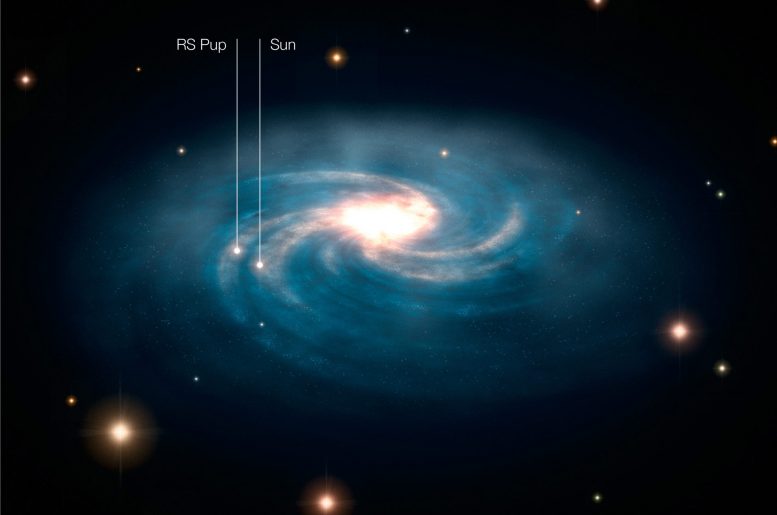
This artist’s impression shows the location of the Cepheid star RS Pup in our Galaxy. From ESO NTT observations of the echoes on several nebular features, the distance of RS Pup was found to be 6,500 light-years, with an uncertainty of 90 light-years. RS Pup is distant by about a quarter of the distance between the Sun and the Center of the Milky Way. RS Pup is located within the Galactic plane, in a very populated region of our Galaxy. Credit: ESA/Hubble & ESO
While this effect is certainly striking in itself, there is another important scientific reason to observe Cepheids like RS Puppis. The period of their pulsations is known to be directly connected to their intrinsic brightness, a property that allows astronomers to use them as cosmic distance markers. A few years ago, astronomers used the light echo around RS Puppis to measure its distance from us, obtaining the most accurate measurement of a Cepheid’s distance. Studying stars like RS Puppis helps us to measure and understand the vast scale of the Universe.
This video morphs the observations of variable star RS Puppis, showing the light echo that can be seen around the star.
This 3D visualization shows Hubble observations of variable star RS Puppis. A stunning example of a phenomenon known as a light echo can be seen around the star, creating the illusion of gas clouds expanding out from RS Puppis.
This video zooms in on the variable star RS Puppis. The sequence begins with a view of the night sky near the southern constellation of Puppis. It then zooms through observations from the Digitized Sky Survey 2, and ends with a view of the star as obtained by Hubble.
This video pans across Hubble observations of variable star RS Puppis. These observations show the ethereal object embedded in its dusty environment, set against a dark sky filled with background galaxies.
Notes
- RS Puppis is over ten times more massive than our Sun, and around 15,000 times more luminous. It lies around 6500 light-years away from us.
- This light echo enabled astronomers to measure the distance to RS Puppis very accurately back in 2008. This measurement is the most accurate ever calculated for a Cepheid.
- This effect can make it appear that this propagation of light is happening at speeds greater than the speed of light, but this is just an illusion.
This brief animation shows the mechanism behind a light echo. A variable star known as RS Puppis is shown to the top right corner of the video, surrounded by clouds of gas and dust. As the star expands and brightens, we see some of the light after it is reflected from progressively more distant shells of dust and gas surrounding the star — creating the illusion of gas moving outwards. This reflected light has further to travel, and so arrives at the Earth after light that travels straight from star to telescope. This is analogous to sound bouncing off surrounding objects, causing the listener to hear an audible echo.
This artist’s illustration shows a star turning into a variable star, expanding and shrinking — growing brighter and dimmer as it does so.


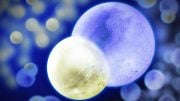
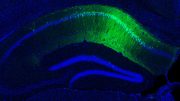
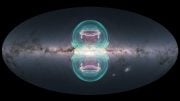

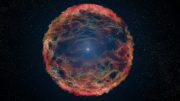


Be the first to comment on "Hubble Views Variable Star RS Puppis"